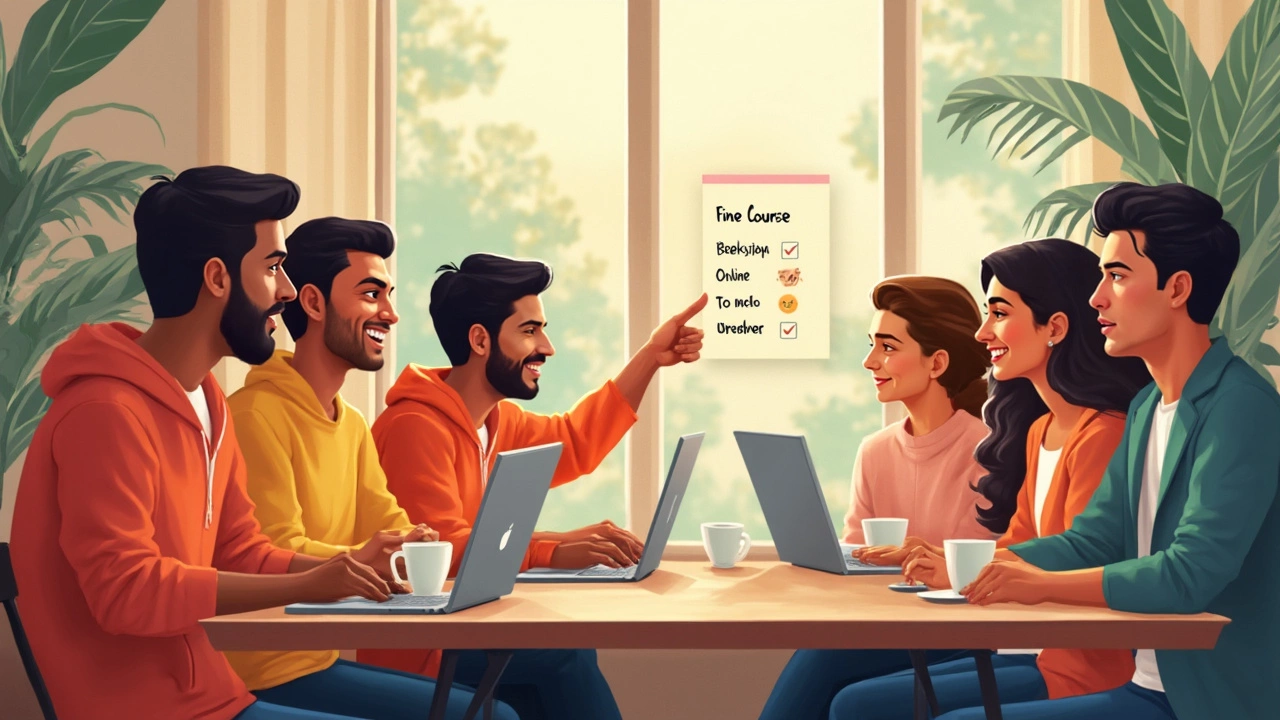Ever wish you could breeze through a course without endless tests or tricky assignments? You’re not alone. Everyone wants a shortcut sometimes, especially if you’re looking to grab a quick certificate or just boost your skills without stress.
The good news—some online courses really are easier than others. They’re not just for the super-smart or the “techie” folks either. There’s a sweet spot where you can learn something new, pad your resume, and still have a life outside the screen. But how do you actually find these gems and not get tricked by clickbait ads?
Right now, thousands of online platforms are pushing courses on literally everything, from basic computer skills to “how to meditate for beginners.” But the catch? Not all online courses are created equal. Some are made for speed, with short quizzes and simple videos. Others drag you through pointless assignments that make you wonder if the certificate is even worth the brain strain.
So before you hand over your cash, you need to know what makes a course truly easy—and how to spot if it’s the right kind of easy for your goals. Let’s break it down: what makes some classes a cakewalk, which ones you should try, and how you can use legit tips to make your next course feel like a walk in the park instead of a sprint uphill.
- Why Some Courses Are Easier Than Others
- Top Picks for the Easiest Online Courses
- What You Actually Learn (And What You Don’t)
- How to Choose an Easy Course That Fits You
- Real Talk: Tips to Pass Without Losing Your Mind
Why Some Courses Are Easier Than Others
Not every online class is going to fry your brain. The secret? A lot comes down to how the course is made and what it expects from you. Some classes serve info in quick, bite-sized pieces. Others want essays, research, and endless group work. Here’s the real breakdown.
- Course Format: Video-based classes or those with short quizzes are hands-down easier to get through. If a course has lots of reading or open-ended projects, get ready for way more hours.
- Subject Simplicity: Let’s be honest—basic computer skills or intro-level personal development courses won’t keep you up at night. Learning Python in two weeks? Not so much. It’s about how tough the topics are and if you need to already know a lot.
- Grading Style: Classes that automatically grade your answers (think multiple choice or true/false quizzes) take way less time and stress. Only a few platforms even require manual marking anymore for beginner-level stuff.
- Access to Support: If there are good forums or 24/7 chat, you won’t spend hours lost in confusion. Simple help makes courses feel a lot lighter.
One surprising stat—according to a 2024 Skillshare report, almost 70% of users pick their first class based on how easy it looks, not what they’ll actually learn. So you’re not lazy for looking for the easiest online courses—you’re just smart about your time.
“The easiest online courses offer straightforward content, clear instructions, and almost instant feedback. Students want all three because they don’t want to waste time.” — Dr. Jamie Lin, Online Learning Analyst, EdSurge
If you want an easy win, keep an eye out for these features. Here’s some quick comparison data showing what people say is hard versus easy:
| Course Feature | "Easy" Rating (out of 10) | "Hard" Rating (out of 10) |
|---|---|---|
| Short Video Lessons | 9.2 | 2.7 |
| Multiple Choice Exams | 8.8 | 3.1 |
| Long Essays/Projects | 2.5 | 9.0 |
| Real-Time Group Work | 3.3 | 8.5 |
At the end of the day, the easiest online courses usually skip busywork, stick to simple formats, and don’t expect you to write the next great novel. If a course looks like it’s just video-watching with a quick quiz, it’s probably your ticket to a fast certificate.
Top Picks for the Easiest Online Courses
Not all courses have the same level of hassle. Some are designed for people who want straight-to-the-point content, simple tests, and quick payoffs. Based on course ratings, open enrollment numbers, and completion stats, here are the usual suspects when it comes to the easiest online courses you can snag.
- Digital Literacy Basics (Coursera, Udemy, LinkedIn Learning): These classes cover stuff like navigating the web, basic emails, or working with Word and Excel. Tasks are straightforward and usually just follow-along exercises. Most people report finishing these in a weekend.
- Personal Productivity & Time Management: Lessons are filled with real-life tips—think creating to-do lists or using apps like Google Calendar. Most quizzes are common sense and you can easily apply what you learned right away.
- Introduction to Mindfulness and Meditation (various platforms): These courses ask you to try simple breathing exercises or reflect on how you feel, usually with zero written work. They’re praised for being relaxing and requiring nearly no effort to pass.
- Social Media Fundamentals: If you already scroll through Instagram or Facebook, this is a walk in the park. You’ll learn basics for posting, boosting engagement, and protecting your privacy. Assessments are often friendly, like short reflections or setting up a basic profile.
- Art & Creativity for Beginners (Drawing, Photography): You follow video lessons at your own pace, submit snapshots of your work, and get quick feedback. No need for fancy materials or prior skills—just a willingness to try.
| Course Name | Average Completion Time | Estimated Pass Rate | Typical Workload |
|---|---|---|---|
| Digital Literacy Basics | 1-3 days | 96% | 2-5 hours total |
| Personal Productivity | 2-4 days | 94% | 3-6 hours total |
| Mindfulness/Meditation Intro | 1-2 days | 98% | 1-4 hours total |
| Social Media Fundamentals | 2-5 days | 93% | 3-7 hours total |
| Art & Creativity for Beginners | 1-4 days | 92% | 2-6 hours total |
Platforms like Coursera, Udemy, and LinkedIn Learning all make it easy to preview content, check reviews, and see what you’re signing up for—so don’t just trust the marketing blurb. Always dig into actual student feedback. If the reviews are full of folks saying, “Finished in one sitting” or “Super easy, no tough homework,” it’s probably as chill as it sounds.
Bottom line: if your main goal is to get a certificate fast, stick to skills-based intro courses or anything aimed at beginners. You won’t get buried in essays or projects, and a lot of these classes are even free or crazy cheap. Just make sure the certificate fits your needs—some employers prefer brand-name platforms, so keep an eye out for that before you hit enroll.

What You Actually Learn (And What You Don’t)
Signing up for the easiest online courses can feel awesome at first. You cruise through short video lessons, answer a few basic questions, and grab a certificate in no time. But what are you really picking up? Let’s get honest about what simple courses actually teach—and what they skip.
Most of the time, these easy courses stick to intro-level stuff. You’ll often find topics like:
- Computer basics (think: using email, making folders, typing faster)
- Time management tips
- Simple nutrition or exercise advice
- Social media 101
- Beginner meditation or mindfulness
Here’s the catch: easy courses are usually about memorizing info, not building hardcore skills. Don’t expect hands-on projects, detailed feedback, or personalized coaching. You won’t finish an easy Photoshop class ready to do paid graphic design work. If a course only takes an hour or two to finish, odds are it won’t teach you to solve tough problems or think outside the box.
To put it in perspective, here’s a table showing the usual differences between easy and more advanced courses:
| Feature | Easy Online Courses | Advanced Online Courses |
|---|---|---|
| Time Required | 30 min to 3 hours | 10+ hours |
| Assignment Type | Multiple choice, short quiz | Long-form projects, essays |
| Feedback | Automated (instant results) | Manual (instructor or peer review) |
| Skills Learned | Basic, surface-level | Intermediate–advanced, hands-on |
| Certificate Value | Good for showing initiative | Useful for jobs/career change |
If you just want to show you took the time to learn something new—like for a LinkedIn badge or personal boost—easy courses work well. But if you need real expertise, a harder, deeper course is the way to go.
Bottom line: the quickest online classes hand you basics. They don’t make you an expert, but they do get your foot in the door or help you try something without a ton of pressure. Just don’t count on stepping out as a pro after a weekend binge-watch.
How to Choose an Easy Course That Fits You
If you want to avoid biting off more than you can chew, picking the right course is half the battle. Just searching "easy course" isn't enough. Each person finds different stuff easy or hard. For example, if you already use social media every day, a beginner's digital marketing class will probably feel like a breeze. But if numbers make your head spin, even a basic Excel course could be a pain.
So, how do you pick an easy class that actually works for you and doesn’t turn into a snooze fest? Here’s a quick guide with things you actually need to watch for:
- Easiest online courses are usually short, self-paced, and focus on practical skills. Look for classes tagged "for beginners" or "no experience needed." If the class lets you learn at your own pace, it means you can rewatch videos and skip when you want.
- Check the syllabus before signing up. If the assignments or tests are just quizzes and you don’t need to write essays or join live sessions, the course likely won’t blow up your schedule.
- See if there are reviews or star ratings. Real people drop hints about if the class is truly easy or just advertised that way. Some websites, like Coursera and Udemy, let folks leave detailed reviews about the hardest (and easiest) parts of the class.
- Prefer video lessons over wall-of-text content. Video-first classes tend to feel less like schoolwork and more like just watching YouTube, which is way easier for most people.
- Avoid anything labeled "accelerated" or "advanced." Even if platforms say a class can be finished in a week, they may jam-pack it with tasks.
It also helps to set your goal: Are you after a certificate only? Or do you want a skill you’ll use? Sometimes, the "easy" course isn’t as useful, so balance fun with what you actually gain. If possible, try free trials or see the first video before buying. Some platforms—like Skillshare and LinkedIn Learning—let you sample lessons for free. That way, you won’t waste money or patience on something that drags you down.
Remember, the “right” course should fit your schedule, play to your strengths, and actually keep your interest for at least the next couple of weeks. Don’t just copy what’s trending—go for what clicks for you.

Real Talk: Tips to Pass Without Losing Your Mind
Even if you pick the easiest online courses, you still have to put in a little effort to actually pass. The trick is not to overthink things or pile on extra work for yourself. Here’s how real people keep it chill and still grab that certificate.
- Check the grading breakdown first: Most easy online courses are all about short quizzes, auto-graded assignments, or discussion boards. Look for classes where tests count the most and there’s no final project “surprise.” If you’re in a rush, skip anything with essays or peer reviews—they eat up time fast.
- Batch your work into sprints: Instead of logging in every single day, block out a couple of times a week to knock out everything at once. Most online platforms (like Coursera, Udemy, and Skillshare) let you binge modules. This helps you stay in the zone and finish faster.
- Use note-taking hacks: Don’t write a novel. Jot down keywords while watching videos or skimming reading material. When quizzes pop up, you’ll have the answers right there—no scrolling back and forth.
- Don’t skip the community posts: If you get points for posting or replying in forums, just say something quick and helpful. No one’s looking for a TED talk. You can even reuse comments if the class is huge—most folks won’t notice.
- Set reminders on your phone: Sounds simple, but about 30% of folks drop easy courses just because they forgot deadlines. Quick phone alerts for “quiz due” or “post response” keep you on track with barely any brainpower.
Curious about which formats are truly low effort? Here’s what students usually face with super-easy online classes:
| Assignment Type | Average Completion Time | Stress Level (1-5) |
|---|---|---|
| Auto-graded quizzes | 10-15 mins each | 1 |
| Short video lectures | 3-8 mins per video | 1 |
| Discussion posts | 5 mins each | 2 |
| Peer-reviewed assignments | 20-30 mins each | 3 |
| Final project/essay | 1-2 hours | 4 |
If you’re aiming to really breeze through, stick to courses weighted toward quizzes and short videos—skip essays if you don’t want surprises. And don’t be shy about searching online for sample quiz answers or summaries. Loads of students share resources, so use them smartly (but don’t just cheat).
One last tip: Go after subjects you already know a bit about. The less you have to learn from scratch, the easier it’ll be. That’s how you really stack the deck in your favor—and finish fast, without stressing out or burning out.
